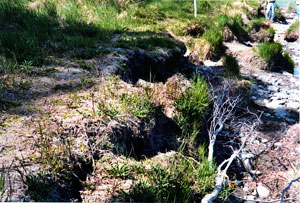Streambank Revegetation and Protection: A Guide for Alaska
How to Use This Guide / Site Considerations
The following pages describe revegetation and protection techniques and their installation. We recommend that you use this guide only as an aid in the creative process of selecting a combination of techniques that will effectively accomplish the revegetation goals of your project.

We have found that successful projects begin with a careful evaluation of site characteristics. Each site is unique. Project planning is enhanced when a cooperative effort between land owner/managers, biologists, permitters, streambank revegetation professionals, hydrologists and engineering consultants is established. A team approach can provide diverse perspectives and expertise with which to develop an effective plan.
When selecting and designing a revegetation project, here are some of the questions, which should be considered and answered via team resource consultation:
- What problem are you trying to solve? What is the intended goal of the project?
- Are you committed to a bio-technical solution to your bank or erosion problem?
- What is the water velocity at the site? How does this velocity affect the streambank or project area? How is flow oriented to the bank?
- Where is ordinary high water level located and what does this mean to your project?
- Where is the thalweg and bottom contour along your stream stretch?
- Determine any upstream and downstream structures and channel modifications that have occurred along your stream stretch. How might these affect your project presently and in the future?
- How is the stream morphology affecting your site? How will it affect the site in the future?
- Is the site area dry during the construction period? Is it possible to dewater or isolate the work area?
- Are there seeps and springs in your bank? How will this affect erosion before, during and after construction? What plant species are best suited for a seeping bank?
- Determine the soil type on site. How will the soil type affect your bank, present erosion, and erosion during construction?
- What measures do you need to consider and implement for erosion control? Have you prepared an erosion control plan?
- What is the erosion potential at your site? What is the present site slope? What should be the natural site slope?
- What is the toe-of-slope erosion rate and shear stress?
- Determine present vegetation on-site and the health of that vegetation. If impacted, what is causing the impact? Is this an impact that will continue and/or increase? What native species are naturally occurring along your stream? What species are best suited for your site? Consider whether your site is fresh water, brackish or salt water and choose those species best suited for the conditions. Please see Plant Secies Selection Lists.
- Who will collect and care for plants? Who will install the project?
- How will access be provided to your site during and after construction? Will you be able to protect the revegetation site?
- For what on-site recreational activities would you like to provide access?
- What local, state, or federal permits will you need to acquire before starting this project? Be sure to give yourself enough time to consult and apply for permits.
- What are zoning restrictions in your area?
- Who owns the land, including rights-of-way for site?
- What is the project cost? Is there funding available for your revegetation project? Please see funding links in the Restoration Grants/Web Links section.
- Are there particular species of native fish or wildlife for which you would like to provide habitat, food or shelter?
Restoration projects may require prior approval from state, federal and/or municipal agencies. We recommend that you contact the permitting agencies early in your planning process (one year before project, in spring or summer) to allow ample time to secure necessary permits, acquire grant funding if applicable, and to acquire assistance. Permit processing will take at least 30 days after filing application, much longer depending on project and agency permitting stipulations. Technical assistance can be obtained by contacting the Alaska Department of Fish and Game, Division of Sport Fish or the Alaska Department of Natural Resources, Plant Materials Center (see Contacts).
In our experience, the best treatment for a streambank is to prevent problems from the very beginning. If at all possible, leave native vegetation intact within the floodzone.
